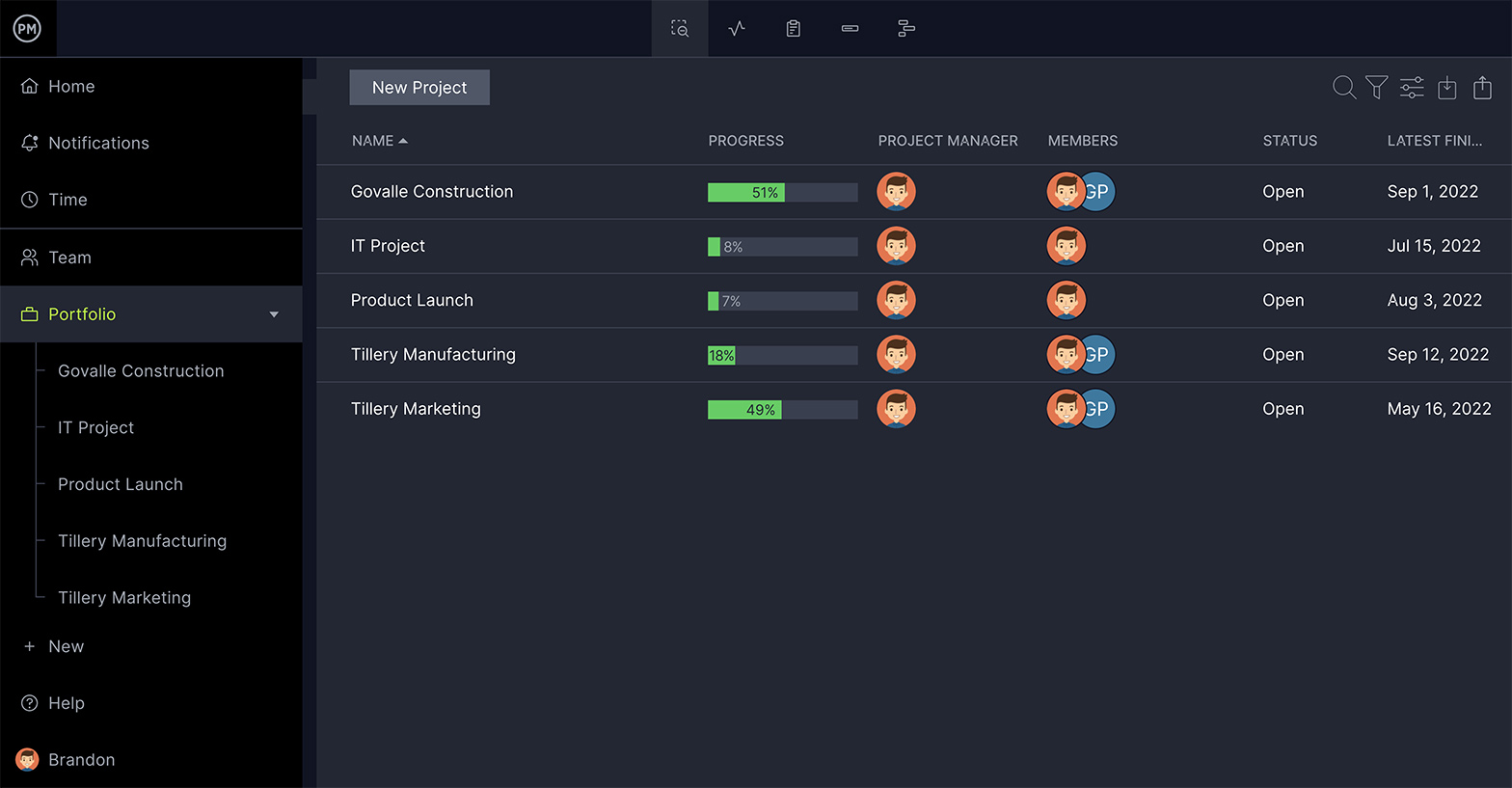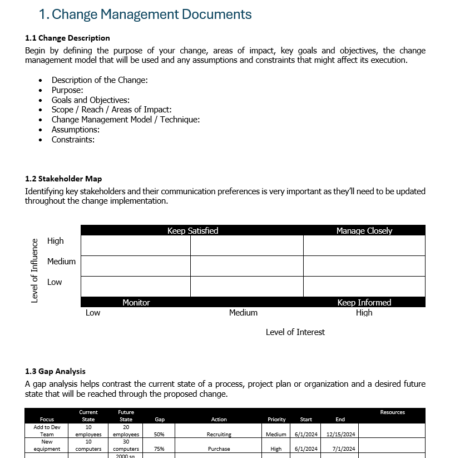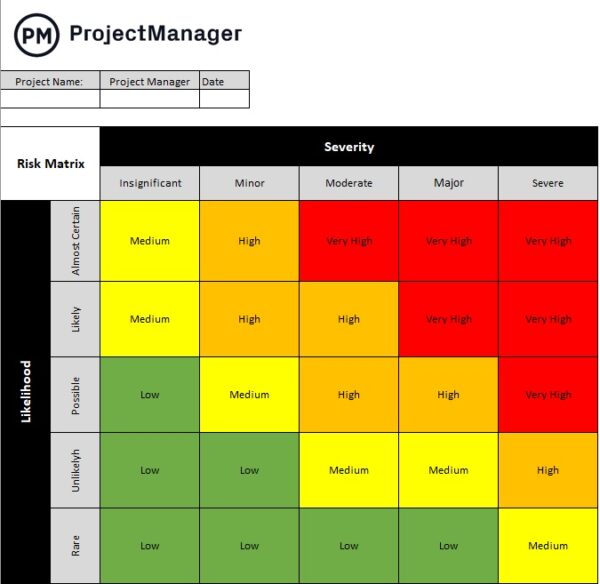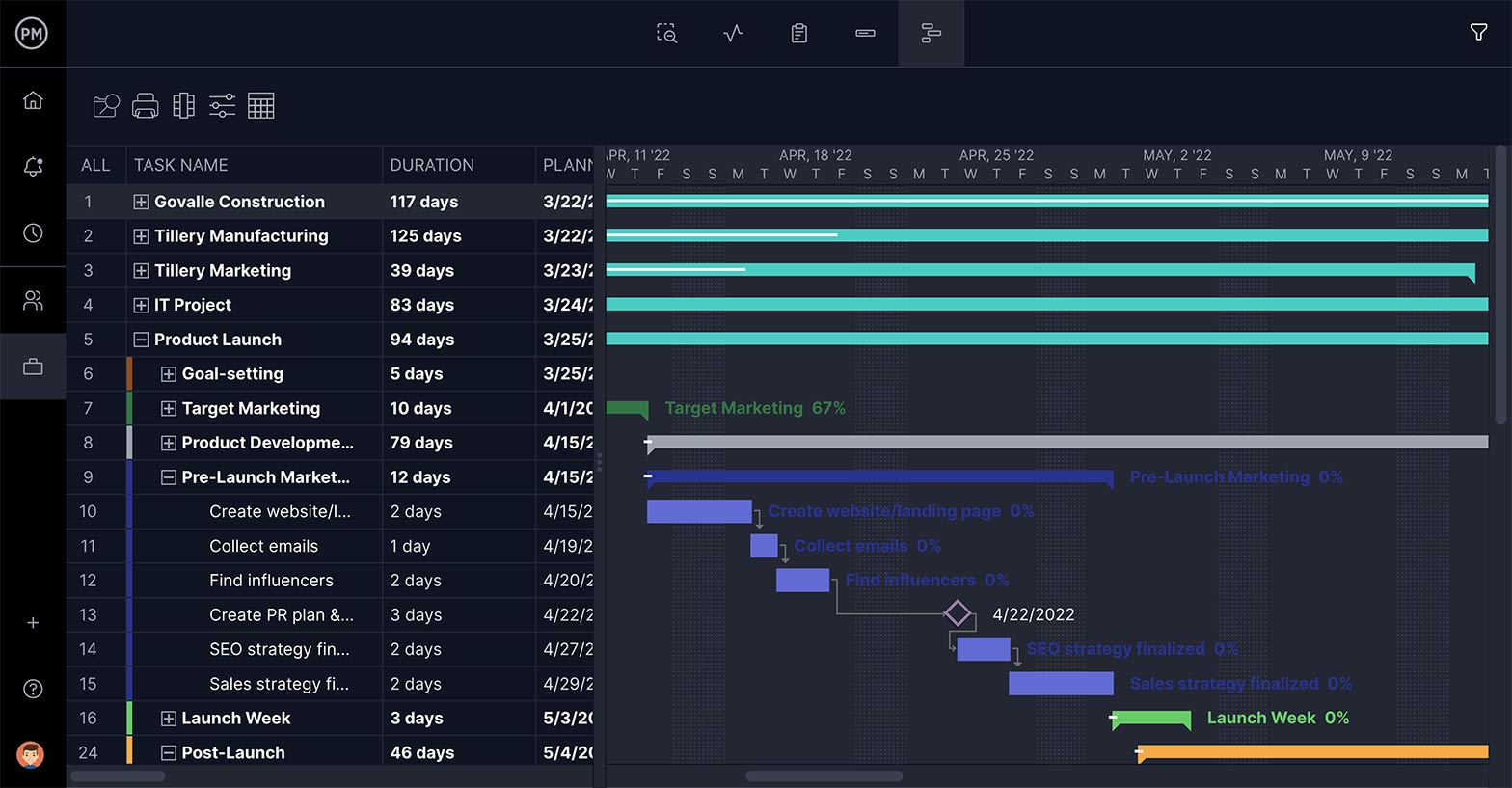A program is a collection of projects that relate to one another and are therefore managed together to achieve maximum resource allocation efficiencies. The advantages of managing these similar projects make them stand better together than by themselves.
However, that doesn’t mean that programs don’t require the same laser focus on planning that individual projects require. A program management plan works similarly to any project plan in that it defines policies, procedures and processes to follow and reach your program goals and objectives.
What Is a Program Management Plan?
A program management plan (PMP) is a document that outlines how a program will be managed from start to finish. It outlines many elements of the program, which we go into in greater detail below. However, it’s important to note that a program management plan can vary depending on the program’s management type and the organization’s requirements.
A program management plan exists to manage, execute and control the program and its goals and objectives. Therefore, the program plan, like any plan, will outline the overview and strategy for the program. To do this, the program must be clearly defined and its scope outlined.

The plan is developed by a program manager, who understands the strategy and objectives of the program. A program plan is concerned more with benefits than deliverables. Its success parameters are not the same as a project in that it doesn’t necessarily need a quality deliverable on time and within budget. For a program plan, success lives in how the program meets the needs and benefits of the organization.
What Should Be Included in a Program Management Plan?
There are many parts to a program management plan. From overall program governance and information on initiatives and projects to related management plans, procedures, times and methods. Below are the key elements that make up a program management plan.
Program Purpose, Goals and Objectives
The first thing anyone making a program management plan needs to do is define what they’re trying to achieve.
Define the purpose of the program and how it aligns with the strategic objectives of the organization and then list the overall goals and objectives of the program to make sure your plan stays within those parameters. You can’t achieve your goals if they’re not clear.
Program Management Team
A program management team oversees and coordinates multiple related projects to ensure they align with an organization’s strategic goals. Here are the roles that work together to manage resources, risks and schedules.
- Program Sponsor: Advocates for the project as a senior management-level leader, though the program sponsor can also be a client.
- Program Manager: This strategic project manager oversees the execution of programs that are aligned with an organization’s objectives, coordinating projects, products and other initiatives across the organization to help the program stay on schedule and budget while achieving its goals.
- Project Managers: The person responsible for planning, organizing and overseeing a project from start to finish, ensuring it’s completed on time, within budget and meets the project’s requirements.
- Key Individuals: These people are important to an organization and have essential responsibilities related to the program.
RACI Chart
A RACI chart, also called a responsibility assignment matrix (RAM) or project assignment matrix (PAM) is used in program management plans to define roles and responsibilities. RACI is an acronym for responsible, accountable, consulted and informed. On a grid with these names, the program manager will place everyone on the team, including stakeholders and others, which will help everyone understand what’s expected of them.

Resource Plan and Program Budget
Next, you’re going to have to deal with the resource allocation for all the projects in your program. That involves defining resource requirements for each project, estimating their costs and then adding them together to make an overall budget for the program management plan.

Ideally, organizations should use the same human and non-human resources for the execution of multiple projects in a program so that they can achieve economies of scale and can reallocate resources strategically by implementing techniques like project crashing.
Program Governance
The plan will include governance, an organizational structure and the process used to plan, control and execute the program plan. This includes a schedule, communication plan, procurement, risk, closeout procedure and all the other general aspects of creating any project plan.
Program Cost-Benefit Analysis
A program cost-benefit analysis is the same as a cost-benefit analysis only directed toward a program. It’s a systemized approach that is used to access the advantages or benefits and disadvantages as in costs associated with the program. The goal is to decide if the benefits of the program outweigh the costs. This can also apply to the individual projects in the program and whether they’re worth pursuing in that they fulfill the larger goals and objectives of the program.
Project Feasibility Studies
Feasibility studies are used to assess whether a project is likely to succeed or not and, therefore, if it should be initiated. A project feasibility study is an independent examination of all aspects of a project, including technical, economic, financial, legal and environmental considerations. It’s also used to identify risks inherent in going forward with the project.
Program Roadmap
Because a program is a collection of many projects, it is helpful to include a roadmap in the plan. A program roadmap is usually set up as a timeline on which the tasks that make up the project are points, with start and end dates. However, since this is a program, there are several projects mapped across the timeline, which helps to strategize and collaborate.

You’ll need to define key deliverables. Even a program has deliverables, as it’s made up of projects. The deliverables might not be the prime reason for the program, but they are important milestones that need to be understood.
Any program is going to have dependencies and constraints. The program plan must identify these and include them in the plan. This includes how the benefits of the program will be realized through its management.

Get your free
Program Roadmap Template
Use this free Program Roadmap Template for Excel to manage your projects better.
Change Management Plan
A change management plan is a document that outlines the strategy and procedures for dealing with a new project or organizational change. A change management plan in a program management plan can also touch on these elements.
- Change Control Board: Manages and oversees changes to a project’s scope, schedule and budget.
- Change Order Request and Approval Process: A formal structure to manage, approve or request a change to a project.
- Change Management Log: A document used to track and record changes throughout the project’s life cycle.

Risk Management Plan
A risk management plan is a document that is used to identify, evaluate and plan for both positive and negative risks for a project. Some of the tools used in the process of risk management include the following.
- Risk register: Used to identify risk.
- Risk matrix: Visual tool to evaluate and prioritize risk
- Risk mitigation strategies: Outlines actions an organization will use to minimize, control or eliminate the impact of risk.

Communication Plan
Communication, as in all projects, is paramount. Without a designated channel, determined frequency and targets, to whom your messages are aimed, there are going to be problems. Communication includes keeping stakeholders updated. In the case of programs, the stakeholders are those in your organization, usually at an executive level, who want to see the return on their investment reflected in your program reporting. The program plan needs to outline those communications, how often and with what materials, including defining their expectations.
Cost Management Plan
A cost management plan is a document used to map and control a project’s budget. It allows project managers to estimate costs, allocate resources to the right areas and control overall spending. The cost management plan keeps all project costs in one place, including direct and indirect costs.
Scope Management Plan
A scope management plan is a set of processes that help project managers define and communicate a project’s scope to stakeholders and ensure that the project stays within specific limits. This is created during the project planning phase and will involve some of the following elements.
- Scope baseline: Defines a project’s scope from the start to the end of its life cycle and is used to monitor progress and measure success.
- Key deliverables: The features or outputs that need to be completed to deliver a product or service.
- Quality standards and acceptance criteria: Quality standards are a set of benchmarks the project or service has to meet and the acceptance criteria is a specific and defined list of conditions that need to be met before a project can be considered completed.
Benefits Management Plan
A benefits management plan is used to identify, plan, measure and track benefits throughout the life cycle of a project. Part of any program management plan can apply to a variety of areas, such as organizational change, processes, project benefits and strategy planning.
Program Management vs. Project Management
Before explaining what a program management plan is, we must be clear on the difference between program and project management. In many ways, they’re similar—except for one fundamental difference.
That difference is that, in project management, your effort is directed solely at producing a final deliverable quickly, without impacting quality and staying on the agreed-upon timeline and budget. Program management, however, follows the lodestar of creating benefits to the organization with synergy from co-management of multiple projects.
Another difference is that projects can be contracted out. The organization running the project is working for a stakeholder, who can or cannot be part of that organization. A real estate company erecting a skyscraper is likely to seek bids from construction contractors, rather than execute the project in-house.
However, programs are managed almost always within an organization. That is, the program manager is not a contract worker, but a part of the larger business; and the program manager is integrally attached to their strategic goals and objectives.
To sum it up, projects are temporary and deliver a service or product, and programs are a group of related projects that are collectively managed to get benefits that cannot be achieved individually.
Tips for Creating a Program Management Plan
When making a program management plan, there are certain things you need to keep in mind. They tend to be similar to creating a project management plan but stay aware of the differences between the two. Remember, a project plan is directed towards its deliverable, but programs have a more strategic goal for PMOs.
Be sure to sure you plan not only with stakeholders but your team. Transparency is important. The team are on the front lines of your project, and they will provide you with valuable data through their engagement and observation. In turn, you want them to know the program plan, so they can make educated choices when forced to act.
Once you’ve met with stakeholders and the teams responsible for executing the various projects, you have both a macro and micro view of the project. This will inform your program plan as you finalize it.
Multiple Project Tracking Template
This multiple project tracking template for Excel can help you monitor the progress of multiple projects simultaneously. Not only that, but it allows you to zoom into the costs, percentage of completion, due dates and priority level of all the tasks that make up each project in your program or portfolio.
We offer a variety of free PMO templates you can use to manage all aspects of your projects, programs and portfolios.
How ProjectManager Helps With Program Management Plans
Don’t forget that all this planning can be facilitated by an online program management tool, such as ProjectManager. Our online tool makes sure you have the most current information to make better, data-driven decisions.
Managing a program is hard, but it’s even more difficult if you’re jumping from project to project to gather data. With our program management software, you get a list of every project in your program. You see the project title, who is managing it, the team executing it and the status. From this high-level view, you can manage your program.
Create Custom Program Dashboards
You can also organize and group your projects using the portfolio dashboard. When you select certain projects and group them in a folder, you can then filter by this group which shows six charts tracking program metrics such as health, workload and progress. With this high-level view of your program’s progress and performance, you can catch issues and make changes to fine-tune the effectiveness of your program.
Track Your Projects with a Roadmap
Another powerful tool is the program roadmap, which collects all the projects in your program and displays them on a Gantt chart timeline. You get to see all of your programs down to the task level in one place and how they relate to one another and if there are any dependencies. But this isn’t a static view. Filter by assignee, project manager or customer, see duration, planned start and finish dates and more. Show stakeholders key metrics during presentations.
To match resources to the capacity of your program, we have robust resource management for your entire program. Features help you track, manage and report on the resources across your program. Our workload page gives you the tools to balance your teams’ workload to boost productivity.
ProjectManager is an award-winning online tool that helps programs get organized to maximize their profitability. Our real-time dashboard, dynamic roadmaps and one-click reporting give you the tools to manage, track and report on progress and performance to keep your program aligned with overall strategic goals. See how we can help your program management plan by taking this free 30-day trial today.
The post How to Make a Program Management Plan (Free Templates Included) appeared first on ProjectManager.







